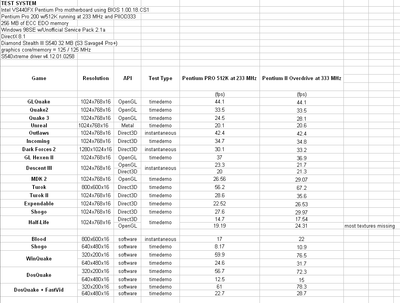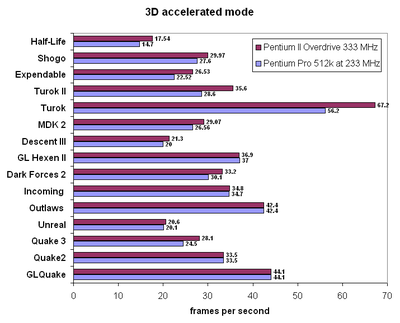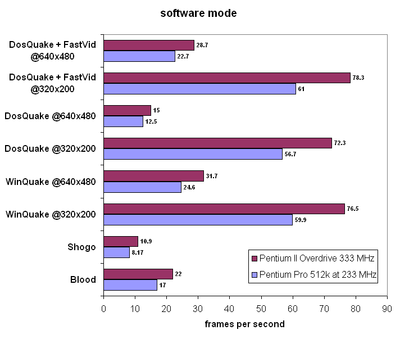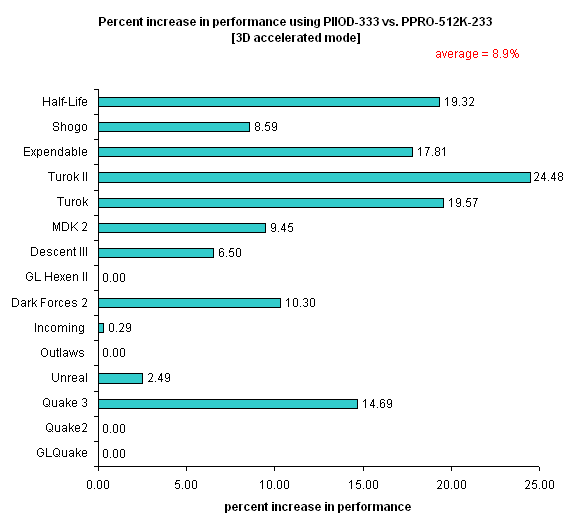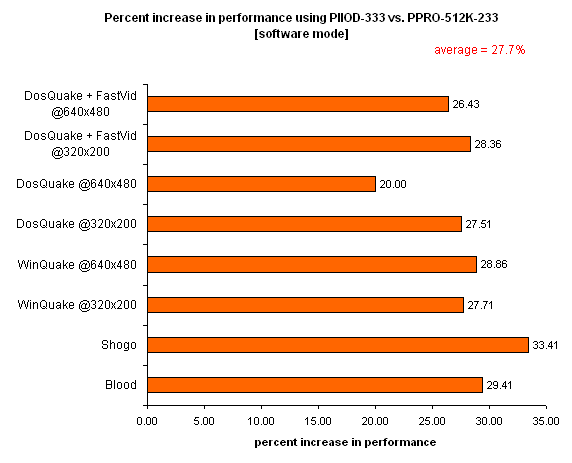Penium Pro 233Mhz 512Kb cache
===========================================================================
Windows:
Quake 2 v3.20 (without Vsync, 1024x768 16-bit, no sound, demo1.dm2) - 56 fps
Quake 2 v3.20 (with Vsync, 1024x768 16-bit, no sound, demo1.dm2) - 42 fps
Quake 3 v1.32 (without Vsync, 1024x768 16-bit, Lightmaps, Medium geometry, no sound, four.dm_68) - 28.3 fps
Quake 3 v1.32 (without Vsync, 1024x768 16-bit, Lightmaps, High geometry, no sound, four.dm_68) - 25.8 fps
Incoming (1024x768 16-bit, no sound, Vsync option does not change fps) - 49 fps
MDK2 Demo (without Vsync, 1024x768 16-bit, Hardware T&L, no sound) - 34.55 fps
MDK2 Demo (without Vsyncm, 1024x768 16-bit, Software T&L, no sound) - 31.92 fps
Expendable (1024x768 16-bit, no sound, Vsync option does not change fps) - 23.6 fps
DOS:
Quake v1.06 (320x200, no sound) - 57.2 fps
Quake v1.06 (640x480 FastVid, no sound) - 22.7 fps
EDIT: Also I've decided to directly compare my Pentium Pro results with Penium II/ASUS P3V4X combo, which has VT82C596B south bridge.
Pentium II 233Mhz Klamath
256Mb RAM SDR 2-2-2-6
ASUS P3V4X (VIA Memory interleave Enabler 0.15 patch)
Quadro4 100 NVS with Detonator 28.32
DirectX 7.0
===========================================================================
Windows:
Quake 2 v3.20 (without Vsync, 1024x768 16-bit, no sound, demo1.dm2) - 52 fps
Quake 3 v1.32 (without Vsync, 1024x768 16-bit, Lightmaps, High geometry, no sound, four.dm_68) - 25.8 fps
Incoming (1024x768 16-bit, no sound, Vsync option does not change fps) - 46 fps
MDK2 Demo (without Vsync, 1024x768 16-bit, Hardware T&L, no sound) - 33.81 fps
MDK2 Demo (without Vsync, 1024x768 16-bit, Software T&L, no sound) - 31.21 fps
Expendable (1024x768 16-bit, no sound, Vsync option does not change fps) - 24 fps
DOS:
Quake v1.06 (320x200, no sound) - 59.1 fps
Quake v1.06 (640x480 FastVid, no sound) - 23.5 fps
I can understand the advantage of upgrading one's CPU to the PIIOD if their primary concern was for data crunching in software mode, but not so much for using 3D graphic card accelerated modes. The gains on said hardware would have been too slow to warrant the price to upgrade.
I think S3 Savage 4 is slowing you down here. Because you're testing everything in 1024x768 resolution. And even if it's 16-bit color, S3 Savage 4 has only 64-bit memory bus. Pentium II Overdrive should scale better. For example, my Expendable result scale up to 21% with Pentium II 300Mhz on the same 66Mhz bus (29.1 fps), so yours should scale around 25-30%. In other words, each 33Mhz above PPro 233Mhz results should give 10% fps increase across the board.
I must be some kind of standard: the anonymous gangbanger of the 21st century.
